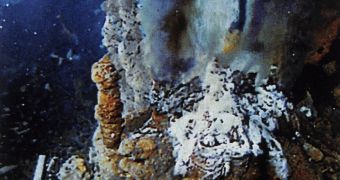There are spectacular geysers on Earth associated with the volcanic activity, but they are rather places of death.
In change, their submarine counterparts, the seafloor vents, can harbor one of the most flourishing and odd ecosystems in the sea bed, based on the food provided by sulphuric bacteria.
They were first discovered 30 years ago, associated to the Mid-Ocean Ridge, a 64,000 km (40,000 mi) long mountain range that zigzags through the middle of the world's ocean bottoms.
Now, after 10 years of hunt, researchers discovered one of the largest fields of seafloor vents pumping super-hot, mineral-rich fluids on a mid-ocean ridge.
The ridges represent the place were the Earth's giant tectonic plates split off and enlarge, as new lava rising from the Earth's mantle is building a new crust. "The discovery of the first active vents ever found on an ultraslow-spreading ridge is a significant milestone event," said Jian Lin, leader of a team of Woods Hole Oceanographic Institution (WHOI) who joined a Chinese expedition to the remote Southwest Indian Ridge in the Indian Ocean in February and March.
The hydrothermal vents have been so far investigated only along the "fast-spreading" East Pacific Rise (100 to 200 mm annually) and the "slow-spreading" Mid-Atlantic Ridge (20 to 40 mm annually).
Due to their remoteness, in the Arctic and Indian Oceans, the researchers could investigate the "ultraslow-spreading ridges" (less than 20 mm annually).
Researchers had supposed that this type of ridges would have fewer vents but in bigger fields. "This cruise confirmed that hypothesis," said Lin, a marine geophysicist and U.S. Coordinator of the 20-day expedition aboard the Chinese research vessel Dayang 1.
The team made the discovery with the help of ABE, WHOI's Autonomous Benthic Explorer, which employs sensors that detect chemical clues leading to a plume of fluids emanating from a vent and collects the data; its sonar builds maps of vent fields and takes pictures about 5 meters above them.
ABE returned with about 5,000 pictures of the robust Southwest Indian Ridge vent site, one of the largest, bigger than a football field (120m x100m or 400 ft x 330 ft).
The expedition was funded by the China Ocean Mineral Resources R&D Association (COMRA), which has been looking for deep sea mineral resources since the early 1990s. "COMRA's primary interests lay in the large sulfide deposits created by hydrothermal vents, which are rich in copper, zinc, gold, and other minerals," said Lin.
"Once ABE pinpointed the site's exact location, the Chinese team sent down its "TV grab"- a grappling device guided by a television camera-and retrieved a reddish chunk of a vent chimney," said Dana Yoerger, scientist in the WHOI Deep Submergence Laboratory and co-designer of ABE, who participated in the expedition.
The necessary data was collected in just six days and three ABE dives.

 14 DAY TRIAL //
14 DAY TRIAL //